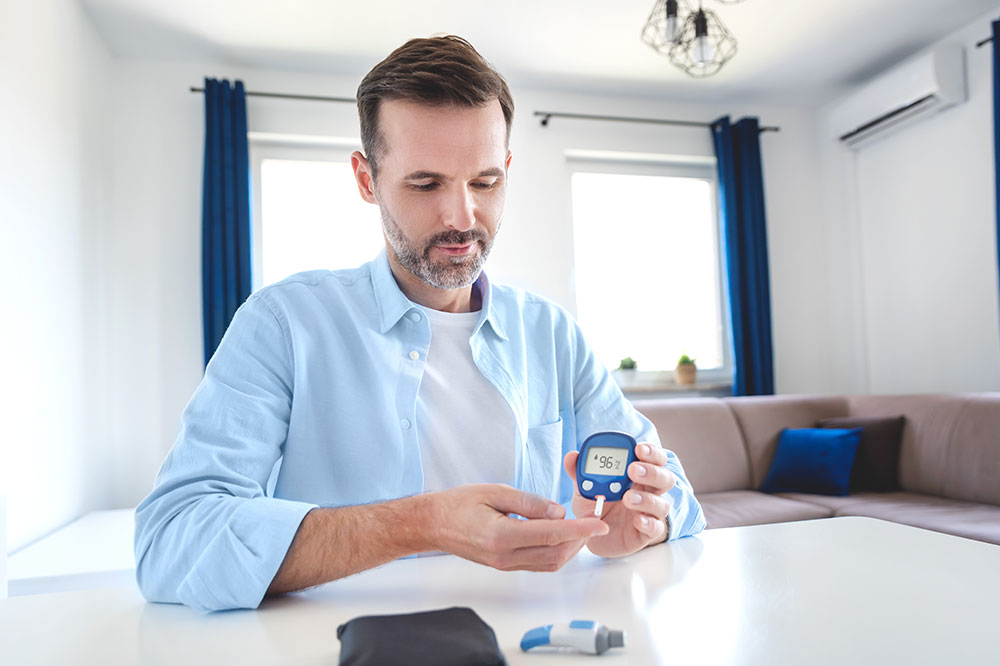Learning about Causes, Symptoms, and Treatments of Hyperglycemia

Glucose (or sugar) is the body’s main source of energy. It is carried throughout the body in our bloodstream to fuel aerobic and anaerobic cellular processes. The body regulates this sugar to ensure it remains at a moderate level to support vital functions. This maintenance is carried out by a hormone called insulin. Improper functioning or lack of insulin can cause a spike in blood sugar levels, also known as hyperglycemia.
Types of hyperglycemia
Hyperglycemia can affect people with type-1 or type-2 diabetes. The two main types of the condition are:
Fasting hyperglycemia
This occurs when a person with diabetes has blood sugar levels above 130 milligrams per deciliter (mg/dl) after not drinking or eating anything for eight or more hours.
Postprandial hyperglycemia
This occurs when someone with diabetes has blood sugar levels of 180 mg/dl or more after 1-2 hours of eating.
What are the causes of hyperglycemia?
A spike in blood sugar could be caused by various reasons, such as:
Skipping insulin treatment
Consumption of excess carbohydrates
Infections or illnesses
Prolonged stress
Long periods of inactivity
Strenuous physical activity
Having high blood sugar levels for extended periods can have an adverse effect on blood cells and make a person more susceptible to medical complications over time.
What are the risk factors associated with high blood sugar?
The most common risk factors for hyperglycemia are:
Type-1 diabetes
Certain genetic or environmental factors can make some people more susceptible to high blood sugar. According to the National Institute of Diabetes and Digestive and Kidney Diseases, viruses and infections may also have an impact on blood sugar levels. Type-1 diabetes is generally unpreventable and begins during childhood or early adulthood. When hyperglycemia is uncontrolled in people with type-1 diabetes, it can develop into ketoacidosis, where ketones (or toxic acids) build up in the blood. This is an emergency that can lead to coma or death.
Type-2 diabetes
Many factors can increase the chances of type-2 diabetes in an individual. These include a genetic predisposition, physical inactivity, age, high triglyceride levels, low levels of good lipoprotein cholesterol, and receiving treatment for high blood pressure. People of African American, Native Alaskan, American Indian, Asian American, Hispanic, or Pacific Islander ethnicities are at higher risk of developing hyperglycemia.
What are the symptoms of hyperglycemia?
Early signs of hyperglycemia include thirst, headaches, trouble in concentration, blurred vision, fatigue, and loss in BMI, along with blood sugar levels above 180 mg/dl. High blood sugar also attracts more water in the kidneys, causing an increase in the quantity of urine passed. People with high blood sugar may even experience sudden or unexplained weight reduction, as many of their blood cells may not be receiving glucose in the right amounts. Hyperglycemia can also lead to numbness, burning, or tingling in the hands, legs, and feet, as a result of a complication of diabetes known as diabetic neuropathy.
People with hyperglycemia may experience vaginal or skin infections, slow-healing cuts or sores, worsening of vision, nerve damage, loss of hair, erectile dysfunction, stomach or intestinal problems such as chronic constipation or diarrhea, and/or damage to the eyes, blood vessels, or kidneys. Symptoms of ketoacidosis include vomiting, dehydration, fruity breath, deep labored breathing or hyperventilation, rapid heartbeat, confusion, disorientation, or coma.
How can hyperglycemia be prevented?
To keep blood sugar levels under control, it is important to do the following:
Keep a check on the total number of carbohydrates in each meal and snack
Get blood sugar levels tested regularly
Keep doctors informed about any irregular blood sugar readings
Follow a regular exercise program
Ensure that prescribed treatments are taken on time
Wear identification at all times in case of emergencies
How is hyperglycemia treated?
People experiencing early signs of high blood sugar must consult with their doctors. Healthcare practitioners may recommend the following:
Drinking more water
Water can help remove the excess sugar in the bloodstream through urine, consequently helping avoid dehydration.
Exercising
Light exercise can help lower blood sugar levels. It is important to speak to the doctor and find the right form and intensity of exercise for each individual, as over-exertion may lead to a spike in blood sugar.
Practicing caution
People with type-1 or type-2 diabetes experiencing high blood sugar must keep an eye out for ketones. They may be advised to stop exercising if ketones are present or asked to practice caution while doing certain forms of essential exercise.
Adhering to nutritional needs
People with hyperglycemia may be asked to meet with nutrition experts to find the types and amounts of food that is right for them.
Switching treatments
Doctors may change the amount, type, or training of prescribed diabetes therapies for people experiencing hyperglycemia. Do not make any changes to treatment patterns without their prescriptions. For people with type-1 diabetes and blood sugar levels above 250 mg/dL, doctors may recommend testing urine or blood for ketones.
When should one visit a doctor?
People experiencing tiredness, increased thirst, frequent urination, or sudden weight loss must consult with a doctor. Make an appointment with the healthcare provider if the following symptoms arise:
Ongoing diarrhea or vomiting, but the body can hold down some food or drinks
Fever that lasts more than 24 hours
Blood sugar levels that stay above 240 mg/dL despite treatment
Symptoms of ketoacidosis
Trouble keeping the blood sugar levels within the target range.
Call for immediate help from doctors if the following occurs:
Ongoing diarrhea or vomiting and loss of ability to keep any food or drinks down.
Blood sugar levels above 240 mg/dL and symptoms of ketones in the urine.
Health and wellness heavily depend on keeping blood sugar levels under control for people with diabetes. To maintain their quality of life, individuals with hyperglycemia must visit their doctors periodically, follow treatments and nutrition guidelines as prescribed, and have their blood sugar levels tested regularly.






